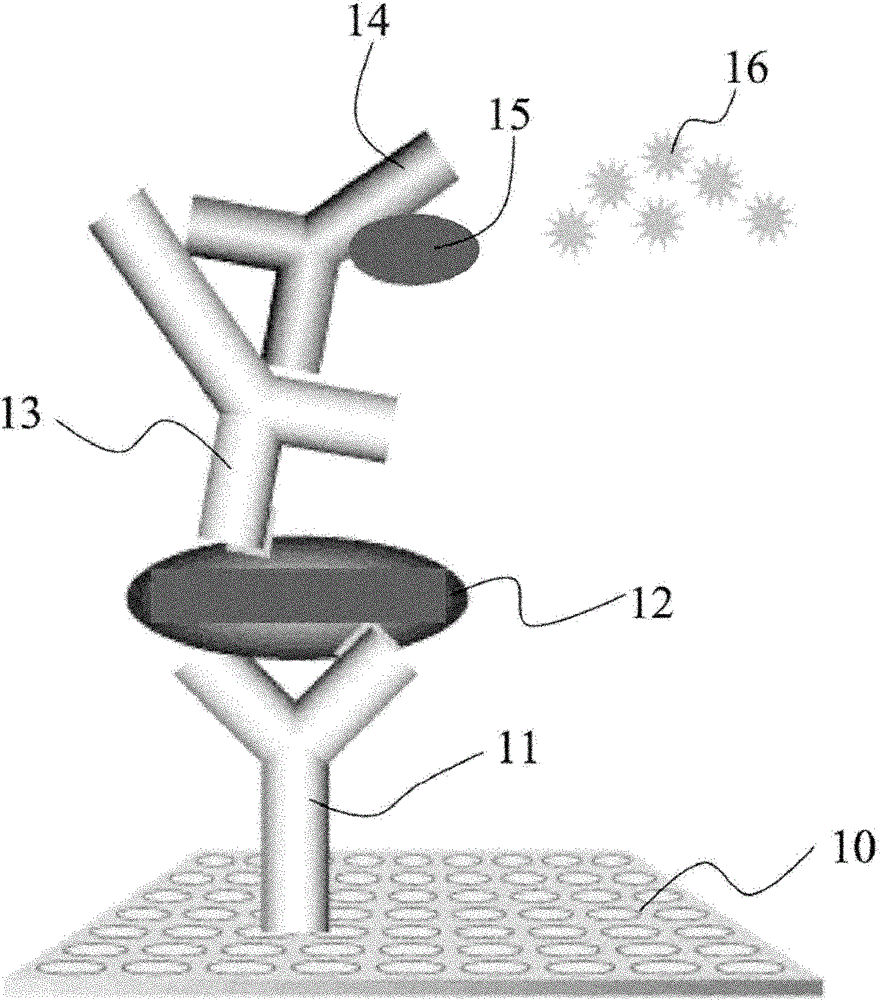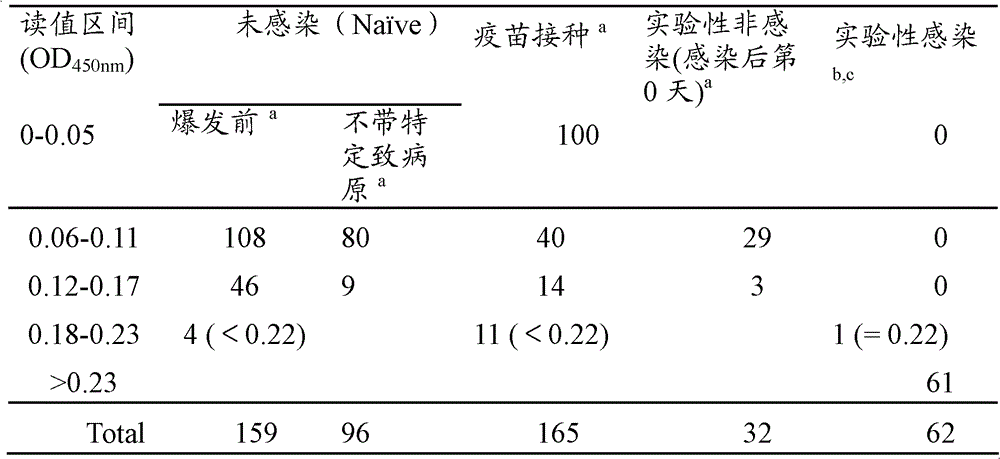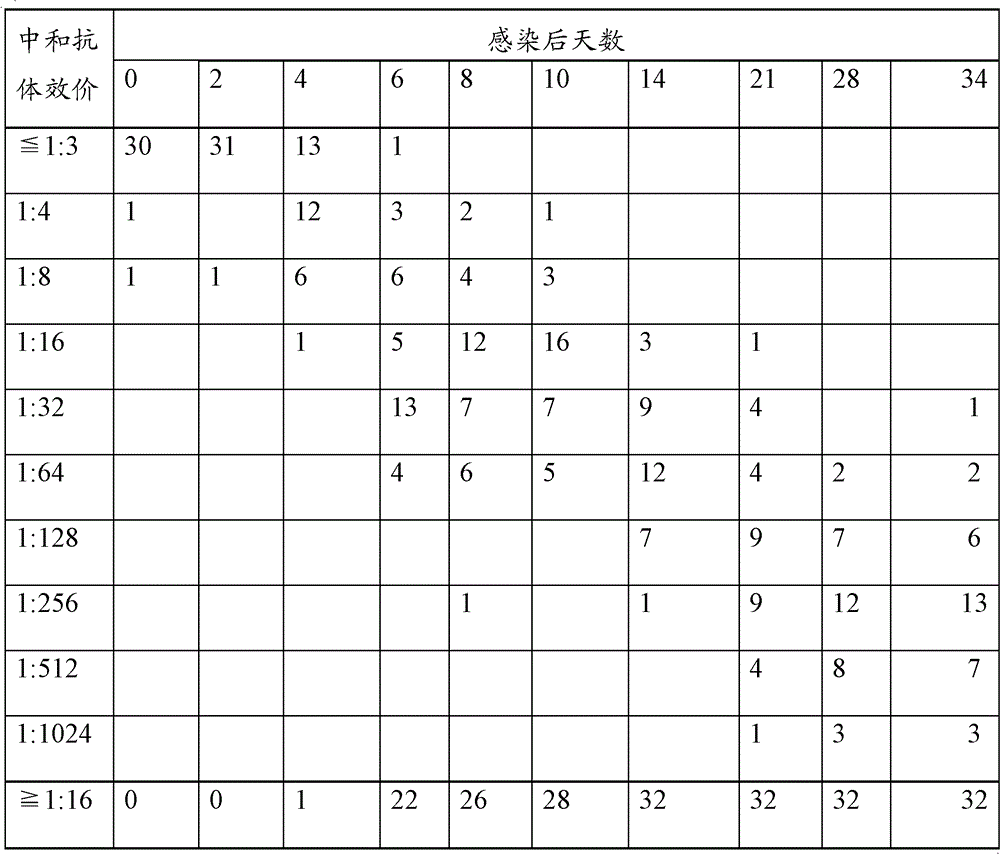Foot-and-mouth disease hybridoma cell lines, monoclonal antibodies, detection reagents and kits
A technology of hybridoma cell lines and monoclonal antibodies, which is applied in measuring devices, botanical equipment and methods, biochemical equipment and methods, etc., and can solve problems such as virus reactivation, poor detection efficiency, and high risk
- Summary
- Abstract
- Description
- Claims
- Application Information
AI Technical Summary
Problems solved by technology
Method used
Image
Examples
experiment example 1
[0052] Experimental Example 1: Materials and Methods
[0053] 1.1: Serum
[0054] To test the sensitivity of the detection, 32 serum samples of FMD-positive pigs were collected from 8-week-old pigs 34 days after the experimental challenge with FMD virus O / TAW / 97 strain.
[0055] In order to compare the sandwich ELISA detection kit provided by the present invention with other three commercially available ELISA detection kits, it was obtained from 32 head without specific pathogen (Specific-pathogen-free; SPF) and experimentally infected with foot-and-mouth disease virus A total of 320 serum samples were collected from pigs with O / TAW / 97 virus strain. The aforementioned 320 serum samples were collected at 0, 2, 4, 6, 8, 10, 14, 21, 28, and 34 days after virus infection. In addition, 30 serum samples collected from pigs 28 days after experimental infection with the FMD O / TAW / 97 strain were also tested.
[0056] To test specificity, 255 serum samples were collected from uninfec...
experiment example 2
[0077] Experimental example 2: Expression of 3ABC recombinant protein in Escherichia coli
[0078] Foot-and-mouth disease virus O / TAW / 993ABC gene sequence is taken from the National Center for Biotechnology Information (NCBI) GenBank database, GenBank accession No.AJ539137, the 5595th to 6119th nucleotide region, and its detailed sequence is shown in SEQ ID As shown in NO: 1, it contains a coding region (Coding region) with a length of 525 nucleotides, so the recombinant protein encoded by it is 175 amino acids long (the sequence is shown in SEQ ID NO: 2). Comparing the genome sequences of serotype O of Pan-Asian FMD strains recently isolated from Asia, Africa and Europe, the gene identity is about 97% to 99%.
[0079] Insert the above DNA fragment amplified by reverse transcription-polymerase chain reaction into pETvector expression vector. The aforementioned expression vector was introduced into Escherichia coli BL21DE3 strain competent cells, and cultured in a Luria-Bertan...
experiment example 3
[0081] Experimental example 3: Mouse immunization and preparation of anti-3ABC monoclonal antibody
[0082] The hybridoma cell line producing anti-3ABC recombinant protein monoclonal antibody was prepared via the following method: 200 micrograms of the 3ABC recombinant protein prepared in Experimental Example 1.5 were used as an antigen to immunize BALB / c mice by subcutaneous injection, and the immune The interval is 4 weeks. Three to four days before cell fusion, the mice were boosted by subcutaneous injection of the same amount of antigen in phosphate buffered saline. The spleens of the immunized BALB / c mice were sacrificed, and the obtained spleen cells were fused with Sp2 / 0 myeloma cells to obtain hybridoma cells. After two weeks, the culture supernatants of hybridoma cells were screened by indirect enzyme-binding immunosorbent assay containing recombinant protein of foot-and-mouth disease virus O / TAW / 97 or O / TAW / 99; The culture supernatant of hybridoma cells was screene...
PUM
| Property | Measurement | Unit |
|---|---|---|
| Sensitivity | aaaaa | aaaaa |
Abstract
Description
Claims
Application Information
 Login to View More
Login to View More - R&D
- Intellectual Property
- Life Sciences
- Materials
- Tech Scout
- Unparalleled Data Quality
- Higher Quality Content
- 60% Fewer Hallucinations
Browse by: Latest US Patents, China's latest patents, Technical Efficacy Thesaurus, Application Domain, Technology Topic, Popular Technical Reports.
© 2025 PatSnap. All rights reserved.Legal|Privacy policy|Modern Slavery Act Transparency Statement|Sitemap|About US| Contact US: help@patsnap.com



